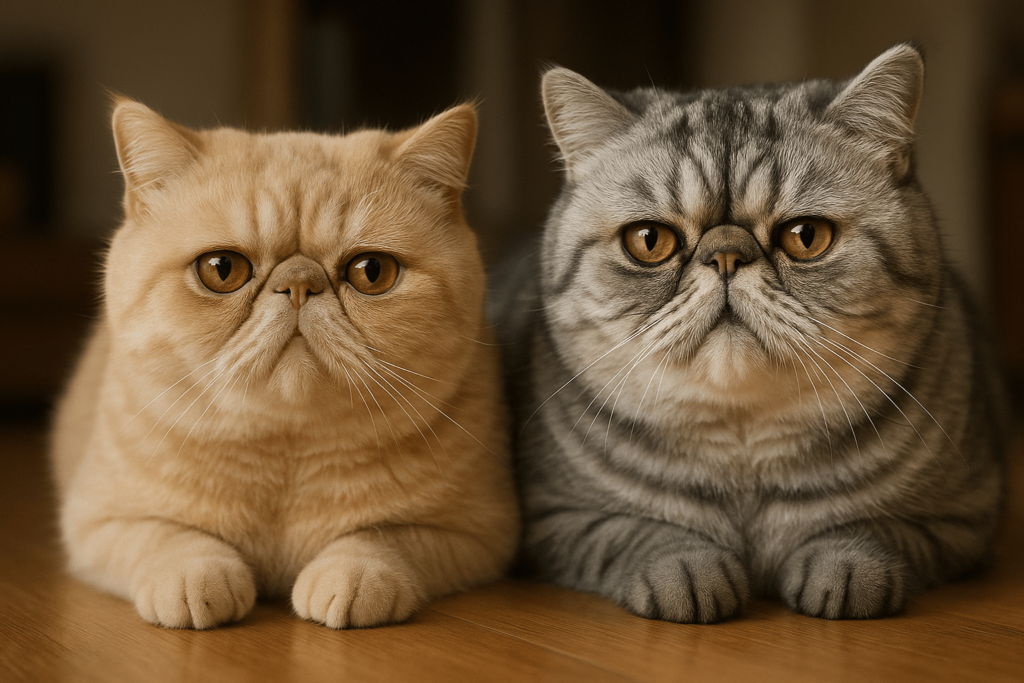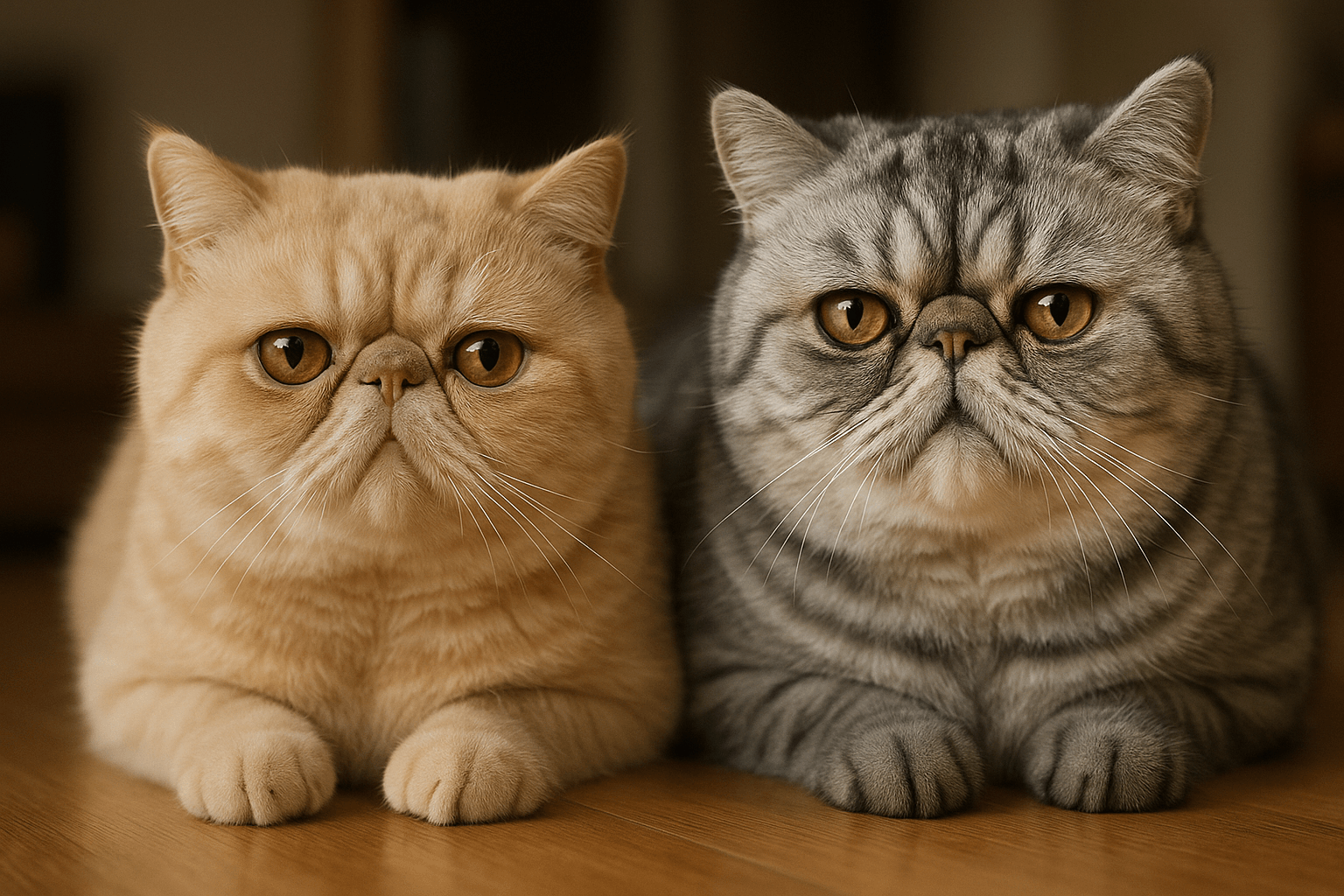Brachycephalic Cats: The Allure and the Hidden Struggles of Flat-Faced Felines
With their large, round eyes, tiny noses, and sweet, squished faces, brachycephalic cats capture hearts at first glance. But behind that adorable appearance lies a complex reality—one shaped by genetics, anatomy, and the quiet challenges of daily life. These cats aren’t just “cute”; they’re living with structural adaptations that impact their breathing, eating, sleeping, and overall well-being. Understanding brachycephalic cats means looking beyond the photos—and into their health, comfort, and the responsibility that comes with loving them.
What Exactly Is a Brachycephalic Cat?
Brachycephaly isn’t a breed—it’s a skull shape. And in cats, it comes with profound biological consequences. Here’s what defines them—and why it matters:
Shortened Skull Structure:
Their facial bones are compressed, resulting in a flattened muzzle and pushed-in nose that alters airflow and space in the upper airway.Narrowed Nasal Passages:
Reduced space inside the nose leads to chronic congestion and difficulty breathing through the nose, even at rest.Elongated Soft Palate:
Excess tissue in the throat can partially block the airway, causing snoring, wheezing, and even choking during excitement.Small Trachea and Laryngeal Issues:
Many have narrower windpipes and malformed larynxes, making physical exertion risky and heat intolerance severe.Eye Protrusion and Dental Crowding:
Their eyes sit more exposed, increasing risk of injury, while teeth are often misaligned due to lack of jaw space.
This isn’t a quirk—it’s a physiological compromise. What looks endearing to us is often a lifelong challenge for them.

The Most Common Brachycephalic Cat Breeds
Not all flat-faced cats are created equal. Some breeds carry this trait more intensely than others. Here are the most recognized—and why their needs differ:
Persian:
The classic brachycephalic cat, with an extremely flattened face, long coat, and high risk of tear duct overflow and respiratory distress.Exotic Shorthair:
Often called the “shorthaired Persian,” they share the same facial structure but require less grooming—making them slightly easier to maintain.Himalayan:
A Persian-Himalayan cross, they inherit the flat face and blue eyes but also the same breathing and eye health vulnerabilities.Scottish Fold:
While known for folded ears, many have brachycephalic features too, especially in extreme lines, compounding joint and respiratory issues.British Shorthair (Extreme Lines):
Traditional British Shorthairs are not brachycephalic—but modern show-line variants have been bred for flatter faces, raising health concerns.
Each breed has its own set of care demands. But one truth unites them: the flatter the face, the greater the risk.
Check this guide 👉Friendliest Cat Breeds for Every Home: Best 7 Expert Tips!
Check this guide 👉Energetic Cat Breeds: Best 7 Expert Tips!
Check this guide 👉Most Affectionate Cat Breeds: Best 7 Expert Tips!
| Common Health Challenges | Why It Happens |
|---|---|
| Chronic snoring and noisy breathing | Narrowed airways and elongated soft palate obstruct airflow. |
| Heat intolerance and panting | Inability to cool down efficiently due to restricted nasal breathing. |
| Eye irritation and tear staining | Protruding eyes and shallow eye sockets lead to constant moisture overflow. |
| Difficulty eating and swallowing | Misaligned jaws and crowded teeth make chewing and lapping hard. |
| Sleep apnea and poor sleep quality | Airway collapse during rest causes frequent waking and oxygen deprivation. |
Why Brachycephalic Cats Are More Sensitive to Heat
Unlike dogs, cats don’t sweat. They rely on panting and nasal airflow to cool down. For brachycephalic cats, this system is broken.
Restricted Nasal Breathing:
With narrowed nasal passages, they can’t take in enough air to cool their body effectively—even on mild days.Panting Is Inefficient:
Cats pant only under extreme stress; brachycephalic cats often pant constantly, signaling chronic distress.Overheating Can Be Fatal:
A temperature of just 85°F (29°C) can trigger heatstroke in a flat-faced cat, while a healthy cat tolerates it easily.No Escape from Humidity:
High humidity makes breathing even harder—air conditioning isn’t a luxury, it’s a necessity.Limited Exercise Tolerance:
Even short play sessions can lead to respiratory collapse. Their bodies simply can’t keep up.
Never assume your brachycephalic cat is “just hot.” If they’re panting, drooling, or lethargic in warm weather, it’s an emergency.
The Hidden Dangers of Everyday Life
Life for a brachycephalic cat is filled with invisible hurdles. What seems normal to us is a daily battle for them.
Car Travel Is Risky:
Stress and confined air can trigger respiratory crisis. Never leave them in a hot car—even for five minutes.High-Pressure Collars Are Dangerous:
Neck collars compress the trachea. Always use a harness if going outside or traveling.Dry Air Worsens Symptoms:
Heaters and AC dry out nasal passages. Use a humidifier, especially in winter.Food Bowls Must Be Shallow:
Deep bowls force them to bend their necks unnaturally, making eating uncomfortable and messy.Grooming Is a Challenge:
Long-haired breeds like Persians need daily brushing. Matting traps moisture, leading to skin infections around the face.
Everyday routines require thoughtful adjustments. Their comfort isn’t optional—it’s essential.
How to Recognize Respiratory Distress in Your Cat
Knowing the signs of trouble could save your cat’s life. These are not “quirks”—they’re red flags.
Noisy Breathing at Rest:
Snorting, wheezing, or grunting when sleeping or relaxed indicates airway obstruction.Open-Mouth Breathing:
Cats rarely breathe through their mouths. If they do, it’s a sign of severe distress.Blue Gums or Tongue:
Cyanosis means oxygen levels are dangerously low. Seek emergency care immediately.Collapse After Minimal Activity:
Even a short chase or jump leading to collapse is a medical emergency.Frequent Gagging or Vomiting After Eating:
Food or saliva pooling in the throat suggests swallowing dysfunction.
If you notice any of these, don’t wait. Schedule a vet visit—not tomorrow, not next week. Now.
Ethical Breeding and the Responsibility of Ownership
The popularity of brachycephalic cats has surged—but so has the cost to their health. Responsible ownership begins before you bring one home.
Avoid Extreme Lines:
Choose breeders who prioritize health over appearance. Look for slightly longer muzzles and less protruding eyes.Ask for Health Clearances:
Reputable breeders provide genetic testing for HCM (hypertrophic cardiomyopathy), polycystic kidney disease, and spinal issues.Never Support Puppy/Kitten Mills:
Cats bred in mass-production facilities are often unhealthy and poorly socialized.Adopt First:
Many brachycephalic cats are surrendered to shelters due to unmet health needs. Adoption saves lives.Educate Others:
Don’t romanticize their struggles. Share the truth: beauty shouldn’t come at the price of suffering.
Choosing a brachycephalic cat isn’t just a lifestyle decision—it’s a moral one.
Daily Care Routine for a Healthy Brachycephalic Cat
Consistent care isn’t optional—it’s life-sustaining. Here’s how to support your cat every single day:
Clean Facial Folds Daily:
Use a damp cotton pad to gently wipe away tear stains and debris from around the eyes and nose.Use a Humidifier in Dry Rooms:
Especially in winter or in air-conditioned homes, moisture keeps nasal passages open.Feed High-Quality, Moist Food:
Wet food is easier to chew and swallow. Avoid dry kibble if they struggle with eating.Keep Them at a Healthy Weight:
Obesity worsens breathing problems. Monitor weight closely and avoid overfeeding.Schedule Biannual Vet Visits:
Early detection of airway or dental issues can prevent emergency surgeries later.
These small acts aren’t chores—they’re lifelines.
FAQ: Brachycephalic Cats
Are all flat-faced cats brachycephalic?
No. Only those with significantly shortened skulls. Traditional British Shorthairs or Russian Blues are not considered brachycephalic.
Can brachycephalic cats live a normal lifespan?
Yes—with exceptional care. Many live 12–15 years, but only if their breathing, weight, and environment are managed proactively.
Do they need special food bowls?
Yes. Shallow, wide bowls or plates allow them to eat without bending their necks painfully.
Is it safe for them to go outside?
Only under strict supervision. Heat, pollution, and stress can trigger respiratory collapse. A secure catio is better than free roaming.
Can I use a fan to cool them down?
Not reliably. Fans don’t lower air temperature—only airflow. Use AC or a cool tile surface instead.
Love Them Fully—But See Them Clearly
Brachycephalic cats aren’t just cute faces. They’re living beings with bodies built for struggle, not ease. Their big eyes reflect not just charm—but vulnerability. Their quiet snorts aren’t adorable quirks—they’re cries for help.
To love a brachycephalic cat is to become their advocate. To choose the humidifier over the heater. To pick the shallow bowl, the harness, the vet bill, the extra minutes of cleaning.
Canned Pumpkin for Cat Diarrhea: Best 7 Expert Tips! Natural remedy to firm stools, soothe upset bellies, and support gut health safely.
Can a Cat Give You Scabies? Best 7 Expert Tips! Discover the truth about feline mites, human skin risks, and how to protect yourself—without panic.
Cat Flea vs Human Flea: Best 7 Expert Tips! Discover the truth about bites, species, and how to eliminate infestations for good.
Weird Cat Behaviors: Best 7 Expert Tips! Discover why cats do strange things—and how to understand, not punish, their instincts for a happier home.





